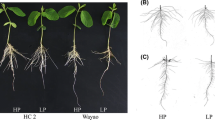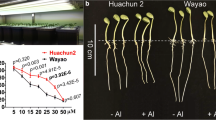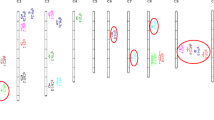Abstract
Soybean is a high phosphorus (P) demand species that is sensitive to low-P stress. Although many quantitative trait loci (QTL) for P efficiency have been identified in soybean, but few of these have been cloned and agriculturally applied mainly due to various limitations on identifying suitable P efficiency candidate genes. Here, we combined QTL mapping, transcriptome profiling, and plant transformation to identify candidate genes underlying QTLs associated with low-P tolerance and response mechanisms to low-P stress in soybean. By performing QTL linkage mapping using 152 recombinant inbred lines (RILs) that were derived from a cross between a P-efficient variety, Nannong 94–156, and P-sensitive Bogao, we identified four major QTLs underlying P efficiency. Within these four QTL regions, 34/81 candidate genes in roots/leaves were identified using comparative transcriptome analysis between two transgressive RILs, low-P tolerant genotype B20 and sensitive B18. A total of 22 phosphatase family genes were up-regulated significantly under low-P condition in B20. Overexpression of an acid phosphatase candidate gene, GmACP2, in soybean hairy roots increased P efficiency by 15.43–24.54 % compared with that in controls. Our results suggest that integrating QTL mapping and transcriptome profiling could be useful for rapidly identifying candidate genes underlying complex traits, and phosphatase-encoding genes, such as GmACP2, play important roles involving in low-P stress tolerance in soybean.







Similar content being viewed by others
References
Altschul SF, Madden TL, Schaffer AA et al (1997) Gapped BLAST and PSI-BLAST: a new generation of protein database search programs. Nucleic Acids Res 25:3389–3402
Baldwin JC, Karthikeyan AS, Raghothama KG (2001) LEPS2, a phosphorus starvation-induced novel acid phosphatase from tomato. Plant Physiol 125:728–737
Cassman KG, Whitney AS, Stockinger KR (1980) Root-growth and dry-matter distribution of soybean as affected by phosphorus stress, nodulation, and nitrogen-source. Crop Sci 20:239–244
Cembella AD, Antia NJ, Harrison PJ (1984) The Utilization of Inorganic and Organic Phosphorus-Compounds as Nutrients by Eukaryotic Microalgae: a Multidisciplinary Perspective 0.2. CRC Crit Rev Microbiol 11:13–81
Chenna R, Sugawara H, Koike T et al (2003) Multiple sequence alignment with the Clustal series of programs. Nucleic Acids Res 31:3497–3500
Churchill GA, Doerge RW (1994) Empirical threshold values for quantitative trait mapping. Genetics 138:963–971
Cordell D, White S (2011) Peak phosphorus: clarifying the key issues of a vigorous debate about long-term phosphorus security. Sustainability 3:2027–2049
Dai XY, Wang YY, Yang A et al (2012) OsMYB2P-1, an R2R3 MYB transcription factor, is involved in the regulation of phosphate-starvation responses and root architecture in rice. Plant Physiol 159:169–183
Deshmukh R, Singh A, Jain N et al (2010) Identification of candidate genes for grain number in rice (Oryza sativa L.). Funct Integr Genomic 10:339–347
Devaiah BN, Karthikeyan AS, Raghothama KG (2007) WRKY75 transcription factor is a modulator of phosphate acquisition and root development in arabidopsis. Plant Physiol 143:1789–1801
Du Z, Zhou X, Ling Y et al (2010) agriGO: a GO analysis toolkit for the agricultural community. Nucleic Acids Res 38:W64–W70
Duff SMG, Sarath G, Plaxton WC (1994) The role of acid-phosphatases in plant phosphorus-metabolism. Physiol Plant 90:791–800
Elser JJ (2012) Phosphorus: a limiting nutrient for humanity? Curr Opin Biotechnol 23:833–838
Gaxiola RA, Sanchez CA, Paez-Valencia J et al (2012) Genetic manipulation of a “vacuolar” H(+)-PPase: from salt tolerance to yield enhancement under phosphorus-deficient soils. Plant Physiol 159:3–11
Gowin S (1997) Phosphorus and potassium effects on soybeans. In: Horticultural crops plant nutrition series (ed S. JB), Texas A&M University, Texas, p. 44–51
Hernandez G, Ramirez M, Valdes-Lopez O et al (2007) Phosphorus stress in common bean: root transcript and metabolic responses. Plant Physiol 144:752–767
Jain A, Poling MD, Karthikeyan AS et al (2007) Differential effects of sucrose and auxin on localized phosphate deficiency-induced modulation of different traits of root system architecture in Arabidopsis. Plant Physiol 144:232–247
Karl AW, James JE, Jessica RC et al (2013) Phosphorus, food, and our future. Oxford University Express, Oxford
Kawasaki S, Borchert C, Deyholos M et al (2001) Gene expression profiles during the initial phase of salt stress in rice. Plant Cell 13:889–905
Kereszt A, Li D, Indrasumunar A et al (2007) Agrobacterium rhizogenes-mediated transformation of soybean to study root biology. Nat Protocol 2:948–952
Kim D, Pertea G, Trapnell C et al (2013) TopHat2: accurate alignment of transcriptomes in the presence of insertions, deletions and gene fusions. Genome Biology 14:R36
Li YD, Wang YJ, Tong YP et al (2005) QTL mapping of phosphorus deficiency tolerance in soybean (Glycine max L. Merr.) Euphytica 142:137–142
Li X, Chang W, Zhang C (2011) Advances of soybean (Glycine max L.) phosphorus nutrition and high P-efficient germplasms screening in China. Soybean Sci 30:322–327
Liang CY, Chen ZJ, Yao ZF et al (2012) Characterization of two putative protein phosphatase genes and their involvement in phosphorus efficiency in Phaseolus vulgaris. J Integr Plant Biol 54:400–411
Lin HJ, Gao J, Zhang ZM et al (2013) Transcriptional responses of maize seedling root to phosphorus starvation. Mol Biol Rep 40:5359–5379
Marino R, Ponnaiah M, Krajewski P et al (2009) Addressing drought tolerance in maize by transcriptional profiling and mapping. Mol Genet Genomics 281:163–179
Meharg C, Khan B, Norton G et al (2014) Trait-directed de novo population transcriptome dissects genetic regulation of a balanced polymorphism in phosphorus nutrition/arsenate tolerance in a wild grass, Holcus lanatus. New Phytol 201:144–154
Mishra M, Das R, Pandey G (2009) Role of ethylene responsive factors (ERFs) in abiotic stress mediated signaling in plants. J Biol Sci 1:133–146
Mizoi J, Shinozaki K, Yamaguchi-Shinozaki K (2012) AP2/ERF family transcription factors in plant abiotic stress responses. Biochimica Et Biophysica Acta-Gene Regulatory Mechanisms 1819:86–96
Murphy J, Riley JP (1986) Citation-Classic: a modified single solution method for the determination of phosphate in natural-waters. Current Contents/Agricul Biol Environ Sci 12:16–16
Nagarajan VK, Jain A, Poling MD et al (2011) Arabidopsis Pht1;5 mobilizes phosphate between source and sink organs and influences the interaction between phosphate homeostasis and ethylene signaling. Plant Physiol 156:1149–1163
Nicholas KB, Nicholas HBJ (1997) GeneDoc: a tool for editing and annotating multiple sequence alignments.
O’Rourke JA, Yang SS, Miller SS et al (2013) An RNA-seq transcriptome analysis of orthophosphate-deficient white lupin reveals novel insights into phosphorus acclimation in plants. Plant Physiol 161:705–724
Olivera M, Tejera N, Iribarne C et al (2004) Growth, nitrogen fixation and ammonium assimilation in common bean (Phaseolus vulgaris): effect of phosphorus. Physiol Plant 121:498–505
Oliveros JC (2007) VENNY. An interactive tool for comparing lists with Venn Diagrams. http://bioinfogp.cnb.csic.es/tools/venny/index.html.
Pachauri V, Mishra V, Mishra P et al (2014) Identification of candidate genes for rice grain aroma by combining QTL mapping and transcriptome profiling approaches. Cereal Res Commun 42:376–388
Petersen LN, Marineo S, Mandala S et al (2010) The missing link in plant histidine biosynthesis: Arabidopsis myoinositol monophosphatase-like2 encodes a functional histidinol-phosphate phosphatase. Plant Physiol 152:1186–1196
Rengefors K, Pettersson K, Blenckner T et al (2001) Species-specific alkaline phosphatase activity in freshwater spring phytoplankton: application of a novel method. J Plankton Res 23:435–443
Robinson MD, McCarthy DJ, Smyth GK (2010) edgeR: a Bioconductor package for differential expression analysis of digital gene expression data. Bioinformatics 26:139–140
Rubio V, Linhares F, Solano R et al (2001) A conserved MYB transcription factor involved in phosphate starvation signaling both in vascular plants and in unicellular algae. Genes Dev 15:2122–2133
Sanchez-Calderon L, Lopez-Bucio J, Chacon-Lopez A et al (2005) Phosphate starvation induces a determinate developmental program in the roots of Arabidopsis thaliana. Plant Cell Physiol 46:174–184
Schmutz J, Cannon SB, Schlueter J et al (2010) Genome sequence of the palaeopolyploid soybean. Nature 463:178–183
Song HN, Yin ZT, Chao MN et al (2014) Functional properties and expression quantitative trait loci for phosphate transporter GmPT1 in soybean. Plant Cell Environ 37:462–472
Tamura K, Peterson D, Peterson N et al (2011) MEGA5:molecular evolutionary genetics analysis using maximum likelihood, evolutionary distance, and maximum parsimony methods. Mol Biol Evol 28:2731–2739
Tian J, Venkatachalam P, Liao H et al (2007) Molecular cloning and characterization of phosphorus starvation responsive genes in common bean (Phaseolus vulgaris L.) Planta 227:151–165
Trapnell C, Roberts A, Goff L et al (2012) Differential gene and transcript expression analysis of RNA-seq experiments with TopHat and Cufflinks. Nat Protoc 7:562–578
Walia H, Wilson C, Condamine P et al (2005) Comparative transcriptional profiling of two contrasting rice genotypes under salinity stress during the vegetative growth stage. Plant Physiol 139:822–835
Walia H, Wilson C, Condamine P et al (2007) Large-scale expression profiling and physiological characterization of jasmonic acid-mediated adaptation of barley to salinity stress. Plant Cell Environ 30:410–421
Wang S, Basten C, Zeng Z (2005) Windows QTL Cartographer 2.5. Department of Statistics. North Carolina State University, Raleigh, NC
Xu EJ, Vaahtera L, Horak H et al (2015) Quantitative trait loci mapping and transcriptome analysis reveal candidate genes regulating the response to ozone in Arabidopsis thaliana. Plant Cell Environ 38:1418–1433
Yang ZK, Zheng JW, Niu YF et al (2014) Systems-level analysis of the metabolic responses of the diatom Phaeodactylum tricornutum to phosphorus stress. Environ Microbiol 16:1793–1807
Yano K, Takashi T, Nagamatsu S et al (2012) Efficacy of microarray profiling data combined with QTL mapping for the identification of a QTL gene controlling the initial growth rate in rice. Plant Cell Physiol 53:729–739
Yin Z, Meng F, Song H et al (2010) Mapping quantitative trait loci associated with chlorophyll a fluorescence parameters in soybean (Glycine max (L.) Merr.) Planta 231:875–885
Zhang D, Cheng H, Geng LY et al (2009) Detection of quantitative trait loci for phosphorus deficiency tolerance at soybean seedling stage. Euphytica 167:313–322
Zhang D, Liu C, Cheng H et al (2010) Quantitative trait loci associated with soybean tolerance to low phosphorus stress based on flower and pod abscission. Plant Breeding 129:243–249
Zhang JX, Wu KL, Zeng SJ et al (2013) Transcriptome analysis of Cymbidium sinense and its application to the identification of genes associated with floral development. BMC Genomics 14
Zhang D, Song HN, Cheng H et al (2014) The acid phosphatase-encoding gene GmACP1 contributes to soybean tolerance to low-phosphorus stress. PLoS Genet 10:E1004061
Acknowledgments
We thank Prof. Gresshoff (University of Queensland, Australia) for providing the A. rhizogenes strain K599. We thank the two anonymous reviewers for their critical and highly valuable comments. This research was supported by the National Natural Science Foundation of China (31301336), the Science and Technology Innovation Talents Projects of the Education Department of Henan Province (15HASTIT034) and China Postdoctoral Science Foundation (2015M580630).
Author contributions
DZ, HZ conceived and designed the experiments. DZ, SC, HL, and YC performed the experiments. DZ and HZ performed data analyses. DZ and HZ wrote the manuscript. DT and DY contributed reagents, materials or analysis tools. All authors read and approved the final version of the manuscript to be published.
Author information
Authors and Affiliations
Corresponding author
Ethics declarations
Conflict of interest
No conflicts of interest declared.
Additional information
Dan Zhang and Hengyou Zhang have contributed equally to this work.
Electronic supplementary material
Below is the link to the electronic supplementary material.
Rights and permissions
About this article
Cite this article
Zhang, D., Zhang, H., Chu, S. et al. Integrating QTL mapping and transcriptomics identifies candidate genes underlying QTLs associated with soybean tolerance to low-phosphorus stress. Plant Mol Biol 93, 137–150 (2017). https://doi.org/10.1007/s11103-016-0552-x
Received:
Accepted:
Published:
Issue Date:
DOI: https://doi.org/10.1007/s11103-016-0552-x




